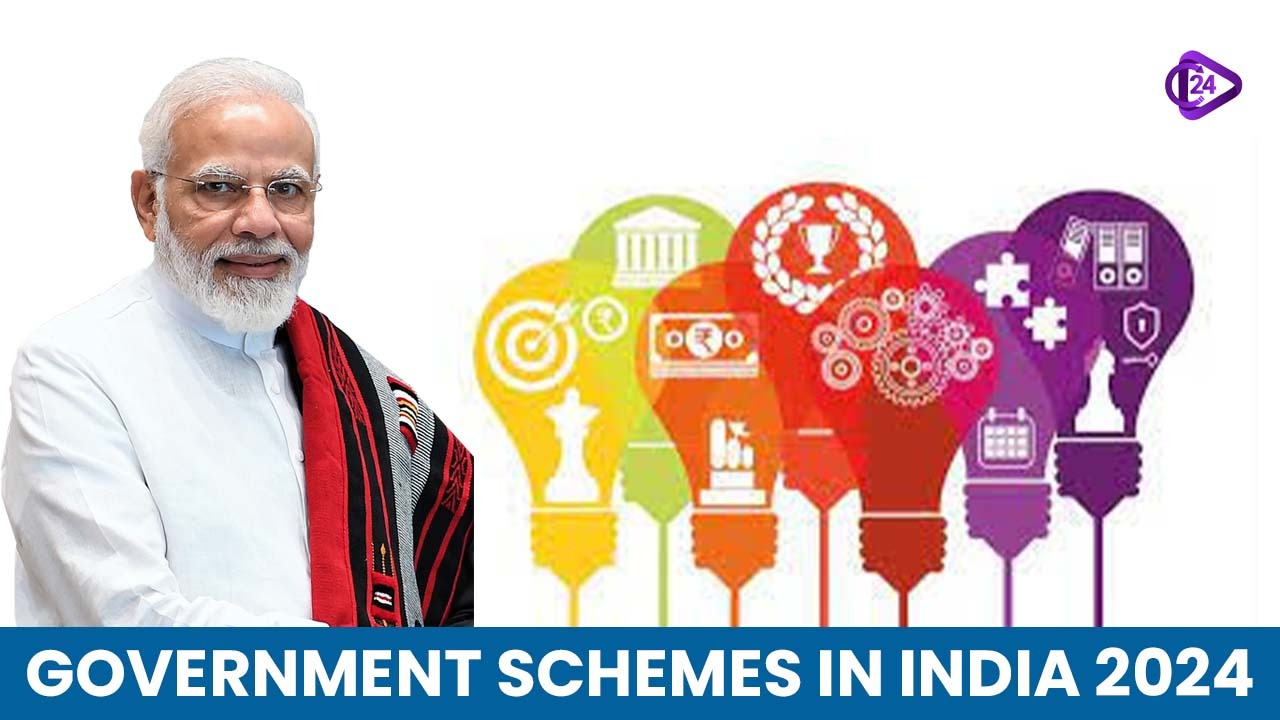Government schemes in India 2024: complete list, objective, and impact

Government schemes in India are those programs initiated by the federal or state governments with the objective of uplifting the general welfare and the most downtrodden people, so as to solve particular socioeconomic problems and encourage economic progress. These encompass various sectors in social welfare, infrastructure, education, health care, and rural development. Their goals are to bridge gaps, reduce inequality, and raise standards of living for all Americans. Here, we go in-depth into the significance, objectives, mode of implementation, and impacts of various schemes propagated by the Indian government.
List of Important Government Scheme of India in 2024
The government schemes of India fall under a large number of topics and, hence, are divided into many different sectors. These sectors include but are not limited to infrastructure, social welfare, employment, education, health, and agriculture. Innumerable such schemes get designed and implemented by various ministries and departments of the Government of India. A small selection of these is described in brief below:
-
Pradhan Mantri Jan Dhan Yojana (PMJDY)
- Pradhan Mantri Jeevan Jyoti Bima Yojana (PMJJBY)
- Pradhan Mantri Surakhasha Bima Yojana ( PMSBY)
- Ayushman Bharat Yojana (ABY)
- Pradhan Mantri Awas Yojana (PMAY)
- Atal Pension Yojana (APY)
- Beti Baachao Beti Padhao Yojana
- Digital India Programme
- Swachh Bharat Abhiyan
- National Rural Livelihood Mission
- Pradhan Mantri Ujjwala Yojana
- Skill India Mission
- Start-up India Programme
- Pradhan Mantri Fasal Bima Yojana
- National Health Protection Scheme
- Pradhan Mantri Mudra Yojana
- Smart Cities Mission
- Udaan Scheme
- Rashtriya Swasthya Bima Yojana
- Poshan Abhiyan
Latest Government Scheme in India
|
Year |
Scheme |
Date of Launch |
|
2024 |
Viksit Bharat by 2047 |
July 23, 2024 |
|
2024 |
Rooftop Solarisation Scheme (PM Surya Ghar Muft Bijli Yojana) |
July 23, 2024 |
|
2024 |
Atmanirbhar Oil Seeds Abhiyan |
July 23, 2024 |
|
2024 |
Employment Linked Incentive Schemes |
July 23, 2024 |
|
2024 |
New Skilling Programme |
July 23, 2024 |
|
2024 |
Pradhan Mantri Janjatiya Unnat Gram Abhiyan |
July 23, 2024 |
|
2024 |
Credit Guarantee Scheme for MSMEs |
July 23, 2024 |
|
2024 |
Credit Support to MSMEs during Stress Period |
July 23, 2024 |
|
2024 |
Comprehensive Internship Opportunities Scheme |
July 23, 2024 |
|
2024 |
NPS Vatsalya |
July 23, 2024 |
|
2022 |
Agneepath Scheme |
June 14, 2022 |
|
2021 |
Startup India Seed Fund Scheme (SISFS) |
April 1, 2021 |
|
2020 |
Ayushman Sahakar Scheme |
October 19, 2020 |
|
2020 |
Mission COVID Suraksha |
November 29, 2020 |
|
2020 |
SERB-POWER Scheme (Promoting Opportunities for Women in Exploratory Research) |
October 29, 2020 |
|
2020 |
SVAMITVA Scheme (Survey of Villages and Mapping with Improvised Technology in Village Areas) |
April 24, 2020 |
|
2020 |
Prime Minister Street Vendor’s AtmaNirbhar Nidhi (PM SVANidhi) |
June 1, 2020 |
|
2020 |
Mission Karmayogi |
September 2, 2020 |
|
2020 |
Sahakar Mitra Scheme |
June 12, 2020 |
|
2020 |
NIRVIK Scheme (Niryat Rin Vikas Yojana) |
February 1, 2020 |
|
2019 |
DHRUV – PM Innovative Learning Programme |
October 10, 2019 |
|
2018 |
Pradhan Mantri Annadata Aay SanraksHan Abhiyan (PM AASHA) |
September 2018 |
|
2018 |
SATAT Scheme (Sustainable Alternative Towards Affordable Transportation) |
October 2018 |
|
2017 |
Pradhan Mantri Vaya Vandana Yojana |
May 4, 2017 |
Government Scheme in India Objective
Government programs have varying objectives, depending on both the industry and the targeted audience However, some of the common objectives are mentioned below:
The Alleviation of Poverty: Many programs strive to lift the poor and disadvantaged by offering basic needs, such as food, shelter, and medical help, in addition to financial support and opportunities to gain employment.
- Poverty Alleviation: The majority of the programs have the ambition to uplift poor and needy people by providing basic amenities of food, shelter, and medical facilities with financial assistance and trying to find jobs for them.
- Social Inclusion: Most of the government programs have a conscious approach toward the reduction of social inequalities and the development of social cohesion. Typically, target groups include OBCs, SCs, STs, and minorities.
- Infrastructure Development: Through enhancing access to energy, communication, transportation, and urban amenities, activities falling under this sub-theme work toward raising living standards and promoting economic growth.
- Health and Sanitation: The healthcare programs recommend universal immunization, access to reasonably priced healthcare facilities, and observance of good sanitation and hygiene practices as primary, secondary, or tertiary preventive measures of lowering disease burden.
- One area of agriculture and social development is the program for the development of rural areas and agriculture. Its objectives are to provide farmers with a higher income by improving agricultural output, building rural infrastructure, and creating sustainable livelihoods in rural areas.
- This also includes the conservation of the environment wherein some of the projects promote practices for sustainable development coupled with the care of the environment; it focuses on biodiversity and climate change in order to conserve the environment.
Government Scheme in India Impact 2024
The lives of Indians and a number of socioeconomic indicators have greatly been transformed by government initiatives. Some of the remarkable impacts of the mentioned above are:
- Poverty reduction: The welfare programs PMAY, NRLM, and MGNREGA have reduced poverty in such a way that these programs have given jobs to livelihoods or homes to millions of households.
- Improvement in Healthcare: Ayushman Bharat-Pradhan Mantri Jan Arogya Yojana has helped improve access to high-quality health services for millions of beneficiaries while simultaneously expanding health cover to offer a degree of financial protection against catastrophic medical costs.
- Access to Education: Different schemes of MDMS and SSA have resulted in an overall improvement in learning outcome, reduction in dropout rates, and enhanced school enrollment, especially amongst the poor and most disadvantaged sections.
- Agricultural Growth: Schemes like PM-KISAN or NMSA have been very helpful for farmers in giving them income support, inputs for agriculture, and knowledge advisory to enhance productivity and improve their incomes.
- Infrastructure Development: The Smart Cities Mission, Pradhan Mantri Gram Sadak Yojana, among other initiatives, have helped raise the quality of life and improved urban infrastructure in both rural and urban areas. Therefore, it supports economic growth and development.
- Empowerment of Women: Schemes like Pradhan Mantri Matru Vandana Yojana (PMMVY) and Beti Bachao Beti Padhao (BBBP) improved the socioeconomic status of women through the promotion of gender equity, education of young girls, and health amongst mothers and children.
Conclusion
Programs initiated by the government in India for 2024 address almost all socio-economic issues. While programs such as Rooftop Solarization Scheme and Viksit Bharat by 2047 were initiated for poverty eradication, advancement of education and healthcare, and improvement in agriculture, infrastructure development is also not lagging behind. Precisely, remarkable improvements are observed in poverty reduction, increased access to health care, increased enrollment at schools, farmer support, and female empowerment. These programs basically focus on various priorities of different development sectors, looking towards the improvement of living conditions and long-term economic expansion that would render India more prosperous and inclusive.




